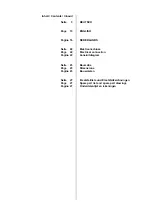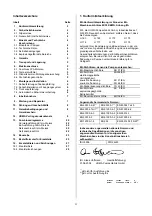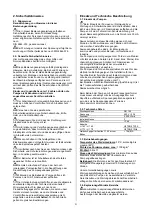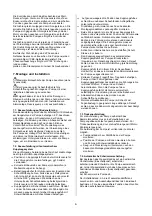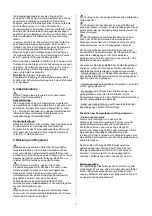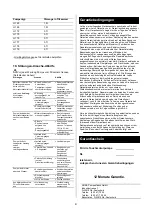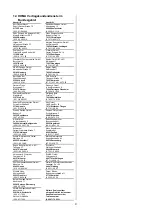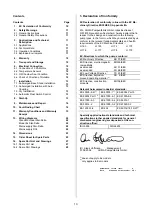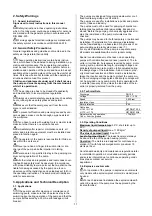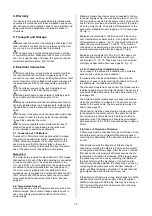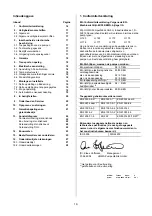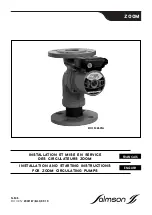
13
7. Installation
Pay attention to the maximum depth of immersion of
the pump (see pump label).
If the pump is installed in a sump, the sump opening
must be covered with a tread-safe cover after installation.
The operator has to prevent damage through the
flooding of rooms caused by defects of the pump through
the use of appropriate measures (e.g. installation of alarm
units, backup pump or like that).
7.1. Submerged Base Stand Installation
A separate ring base stand, which is available as an ac-
cessory must be fixed at the bottom of the pump.
Fix a 90° elbow to the pump discharge. The pump may be
installed with a flexible discharge hose or a rigid pipe,
non-return valve and isolating valve. If a flexible hose is
used, make sure that it does not buckle.
Fix a chain to the pump handle and lower the pump into
the liquid. If the pump is installed on muddy ground,
support it on bricks to prevent if from sinking in.
7.2. Submerged Installation with auto-coupling
Permanent installation of the pumps can be done on a
stationary auto-coupling. The following instructions refer
to the use of the original HOMA system.
⇒
Place the auto-coupling base unit on the bottom of the
pit. Use a plumb line to fix the correct position of the
guide rail bracket on the inside of the pit cover. Drill
mounting holes and fasten the guide rail bracket provi-
sionally with 2 screws.
⇒
Put the auto-coupling base unit in the exact position and
fasten with expansion bolts to the pit bottom. If the bot-
tom is uneven, the base unit must be supported to be in
horizontal position.
⇒
Assemble the discharge pipe in accordance with the
generally accepted procedures and without exposing the
pipe to distortion or tension.
⇒
Insert the guide rails in the ring of the auto-coupling
base and adjust the length of the rails by cutting them
accurately to the guide rail bracket.
⇒
Unscrew the provisionally fastenend guide rail bracket,
fit it on top of the guide rails and fasten it to the pit
cover. Make sure that the guide rails do not have any
axial play, as this would cause noise during pump op-
eration.
⇒
Clean out debris from the pit before lowering the pump
into operation position.
⇒
Fit the coupling flange at the discharge of the pump.
Make sure that the rubber profile-seal is properly fixed to
the flange and will not fall off when the pump is lowered
into the pit. Slide the guide bar of the coupling flange
between the guide rails and lower the pump into the pit
by means of a chain secured to the pump handle. When
the pump reaches the auto-coupling base unit, it will
automatically connect tightly.
⇒
Hang up the end of the chain to a suitable hook at the
top of the pit.
⇒
Adjust the length of the motor cable, so that it is not
damaged during the pump operation. Make sure that the
cables are not sharply bent or pinched.
7.3. Dry Installation
For installation of the pump outside the collection sump, a
suction pipe must be connected to the pump inlet.
Only pumps with motor jacket cooling must be used for
dry installation.
The pump may be installed vertical or horizontal.
⇒
Fit the bracket or the basestand to the pump.
⇒
Mark and drill mounting holes in the concrete floor.
⇒
Fasten the pump with expansion bolts.
⇒
Connect the motor cable and the monitoring cable.
⇒
Fit the suction and discharge pipes and isolating
valves, if used, and ensure that the pump is not
stressed by the pipe work.
7.4. Automatic Float Switch Control
The pumps may be supplied with float switch level con-
trollers. They start and stop the pump according to the
liquid level in the pit.
The difference in level between start and stop must be
adjusted by adjusting the free swinging length of the ca-
ble between the float switch and the cable fastening.
Long cable end: Large difference in level. Short cable
end: Small difference in level.
The stop level must be adjusted in such a way, that the
pump stops before the liquid level is lowered below the
top of the pump housing.
The start level must in any case be below the bottom of
the liquid inlet pipe of the pit.
The high alarm level, if a separate float switch for that is
installed, should be adjusted approx. 10 cm above the
start level, in any case it must be below the bottom of the
liquid inlet pipe of the pit, so that the start level must be
adjusted accordingly.
Never place the float switch in the sump without fixing the
float switch cable to a fixed point in the sump, because
the float switch needs a rotation around the fixing point of
the cable to operate without any problems. Non-
observance may cause an overflow because the pump
does not start running or a dry run of the pump in fact that
the pump does not stop, which will destroy the pump.
Note:
Only the proper adjustement and fixing of the float
switch cable will guarantee a reliable pump operation. Af-
ter any modification of the float switch adjustment the
function must be checked by a test-run of the pump.
8. Start-Up
Never let the pump run dry for a long time of period,
as it will destroy the pump (danger of overheating).
Wet well installation
Start the pump, when the system has been filled with liq-
uid and vented. Open the isolating valves. Check the po-
sition of the float switches. If necessary, check the direc-
tion of rotation of the pump, as described under 6.4. Put
the switch on the control box to the required mode of
operation.
Dry well installation
On dry installation, make sure that the liquid level in the
collection sump is above the top of the pump housing to
prevent an air cushion in the pump.
If necessary, check the direction of rotation of the pump,
as described under 6.4. Put the switch on the control box
to the required mode of operation.
Summary of Contents for Baureihe H 163
Page 30: ...30 H 172 H 179 H 172 Ex H 179 Ex H 172 U H 179 U H 172 U Ex H 179 U Ex ...
Page 31: ...31 ...
Page 32: ...32 ...


